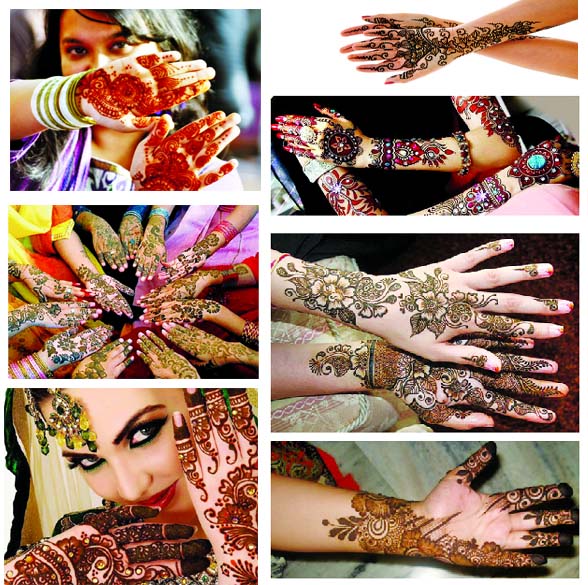
Maria Mohsin :
Eid mehndi refers to the intricate designs drawn on the hands of Muslim women using henna ink to celebrate the end of the Ramzan fast. Eid-ul-Fitr is a Muslim holiday that falls on the first day of the tenth month of the Islamic calendar, and the festivities last for three days. Frequently referred to simply as Eid, the holiday is similar to New Year’s Day.
During this holiday, observant Muslims are forbidden to fast. Although attending prayers is not obligatory, Muslims are encouraged to go for fellowship. They are also encouraged to dress up in their best clothes. For many Muslim women in South Asia, North Africa, and the Middle East or women whose heritage is based in these cultures, dressing up for Eid includes wearing Eid Mehndi.
The term Mehndi (Henna) simply refers to the henna used as the ink. Henna has been used as a dye for centuries, colouring the hair of women, the beards of men, and the manes and tales of horses. Believed to have healing properties, henna was also used to dye hands and feet. There is some evidence that the practice began with the Egyptian pharaohs before becoming popular in other regions.
Muslims around the globe has adopted traditions inherent in the culture of the country they live in. Still, there are many Islamic traditions that unite Muslims regardless of ethnic or cultural background. There are two main celebrations of Muslims, Eid-ul-Fitr and Eid-ul-Azha. Eid-ul-Fitr is celebrated at the end of the fasting month Ramzan as a gift from Allah and has a special significance for Muslims. In Pakistan, special arrangements are done on this occasion, particularly girls get very excited for their Eid arrangements, especially for henna. They are fond of henna even their Eid is considered incomplete without henna.
In Pakistan, henna is considered very auspicious for religious occasions and for weddings. Henna has existed from centuries and was usually drawn on the palms and feet.
According to my grandmother, before the modern era henna was prepared at home by grinding henna leaves in a paste with water and oil. There was no consideration of design like today; they just used to apple henna paste on their hand. Another popular design was, a circular pattern is drawn and filled in the centre of the palm. Fingertips are also covered with henna. This design is still very popular today. Toothpick was also used to make designs in the early days before henna cones were made available.
Types of Henna Design
There are many different styles of henna, depending on the cultural background they come from. The most famous ones are Arabic, Pakistani, African and Indian.
Pakistani and Indian Henna Style
Pakistani and Indian henna style is very popular and very diverse. They range from simple designs to complex. Pakistani henna is known for it’s detailed and fine fill-ins.
Arabic Henna Style
Compared with the complex Pakistani and Indian henna designs, Arabic designs are much simpler. Arabic designs mostly consist of leaves, veins, flowers etc. Another distinguishing feature of Arabic designs is that the shapes are not filled, they are just outlined.
African Henna Style
Moving over to the African continent. Just like the Arabic counterparts these henna designs are also not filled. These designs are simple geometric shapes, consisting of lines, squares and dots.
Applying Henna Designs
Today henna filled cone is used to apply henna designs. The benefit of using a cone is that you can achieve incredibly fine lines with it. Hold cone like a pencil in your hand and apply design.
Henna designs look prettier when something decorative is added to it. Today, glitter of different shades is used in designs for
filling and for shading in flowers. It is great for kids because they love glitter. For a glamorous look you can make an outline of design with glitter.
Another advance approach, which you can apply, is Kunden and crystals in design of arms and legs (for half sleeves and Capri). These types of henna designs look awesome. You can also make small heart shape leaves around filled circular in the centre of the palm and on opposite side use beads around filled circular.
How dried Henna is removed?
Do not use water when removing the dried henna paste. The paste should be scraped off and any stubborn bits can be removed using henna oil or olive oil.
Tips to get deeper Henna colour
Everyone seems to want deeper henna colour on their palms. I want to help you achieve this with following useful tips.
F Apply a fixative solution to the design, which consists of lemon juice, and a pinch of sugar with cotton ball.
F When henna design is dried completely warm up your hands on clove smoke.
F Once the henna starts to fall off, apply ‘Vicks VapoRub’ on your hands.
F Use of oil in the applied area can protect henna from fading.
F When the henna starts to fade and appears patchy, it can be removed by applying cosmetic body bleach.

